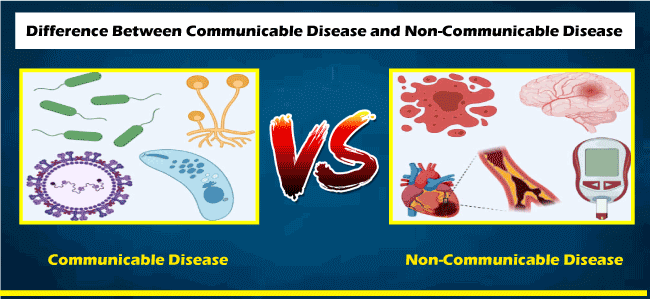Difference between Communicable and Non-Communicable DiseaseThis is a disturbing time as the pandemic is taking a toll on us. People everywhere are dying due to the deadly COVID-19. Diseases like blank fungus, yellow fungus, etc., are also coming into being. People are suggested to stay inside their homes and do yogic practices and take care of themselves. Fortunately, the situation is under control, but in some areas, the disease is intact and growing. The fear of COVID-19 is lurking in the minds of people. Well, this is a fatal disease, and we have discussed it earlier in detail. So today, let's discuss about the other kinds of diseases, i.e., communicable and non-communicable diseases. Now, what are non-communicable and communicable diseases? Is it fatal? What are its symptoms? How can we overcome it? These questions are often asked by people having these disorders. So, let us start by knowing the fundamental definition of these terms. 
Communicable DiseaseCommunicable diseases, as the name suggests, are diseases that are easily transmitted to the other person. These diseases are caused by some infections, pathogens, flu, hantavirus, Ebola, or human/ animal hosts. Some disorders under communicable diseases are measles, hepatitis A, B, C, blood-borne disease, etc. Now, these diseases are spread by sexual intercourse, contaminated food consumption, insect bites, skin contact, etc. Some common symptoms of communicable diseases are fever, fatigue, muscle pain, body pain, cough, cold, loss of weight, loss of appetite, etc. The history of communicable diseases has recorded four stages of illness, i.e., stage of exposure, the stage of infection, the stage of infectious disease, and the outcome stage. Communicable diseases move with these four stages. Before it becomes a fatal disease, one must take precautions and necessary medications to stop it at an early stage. Non-Communicable DiseaseA non-communicable disease is defined as the disease that cannot be transmitted from one person to another. They are generally chronic ailments that can last for a long time period. Diseases like cancer, diabetes, cardiovascular disease, chronic respiratory ailment, mental disorders, etc., are common non-communicable diseases. These are chronic ailments and can last lifelong. Diseases like diabetes cannot be cured fully, but they can be controlled by medications. These diseases can be caused due to eating tobacco, having alcohol, an unhealthy diet, lack of exercise, etc. Out of these, the major cause of non-communicable disease is an unhealthy lifestyle. People live in particularly bad conditions, which leads them to have such diseases. Well, these disorders can be cured through medication, except for some. But it is important to note that these diseases can strike back after getting cured. For instance, if someone has blood cancer, once getting cured, the patient can still have blood cancer after a year or so. Therefore, it is important to have a good lifestyle in order to avoid contact with such ailments. Now, let us discuss the significant contrasting points between communicable and non-communicable diseases.
So, these are some of the significant contrasting points between non-communicable and communicable diseases. It is interesting to note that communicable and non-communicable diseases have specific side effects on the human body. Since communicable diseases are cured by medication, they do not have much effect on the body. On the contrary, non-communicable diseases have a grave effect on the body both internally and externally. Now, let us look at some of the characteristics and facts related to communicable and non-communicable diseases. Characteristics of Communicable Diseases
Characteristics of Non-Communicable Diseases
So, these are some of the characteristics related to non-communicable and communicable diseases. These diseases take their time to cure, but non-communicable diseases can relapse during the medication or after that. Non-communicable diseases are not easily cured. Thus, communicable and non-communicable diseases occur in humans and can be cured/ controlled through medications.
Next TopicDifference between
|
 For Videos Join Our Youtube Channel: Join Now
For Videos Join Our Youtube Channel: Join Now
Feedback
- Send your Feedback to [email protected]
Help Others, Please Share










